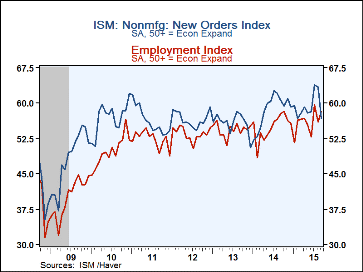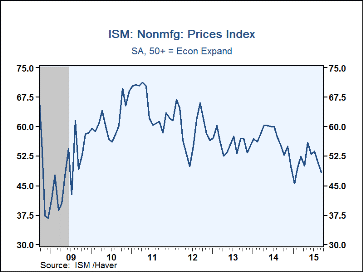 Global| Oct 05 2015
Global| Oct 05 2015U.S. ISM Nonmanufacturing Index Declines, Led by Orders
by:Tom Moeller
|in:Economy in Brief
Summary
The Institute for Supply Management (ISM) Composite Index of Nonmanufacturing Sector Business fell to 56.9 during September from an unrevised 59.0 August. Despite the decline, the average during the third quarter of 58.7 was its [...]
The Institute for Supply Management (ISM) Composite Index of Nonmanufacturing Sector Business fell to 56.9 during September from an unrevised 59.0 August. Despite the decline, the average during the third quarter of 58.7 was its highest since Q3 2005. Consensus expectations had been for 57.8 in the Action Economics Forecast Survey.
Haver Analytics constructs a Composite Index using the nonmanufacturing ISM index and the ISM factory sector measure, released Thursday. It fell to 56.1 from 58.0, leaving the Q3 average at its highest level in a year. During the last ten years, there has been a 73% correlation between the index and the q/q change in real GDP.
The decline in the composite index was led by a sharp drop in new orders 56.7, its lowest reading since February. The business activity reading also eased to 60.2, the lowest level in four months. The supplier deliveries index held steady m/m but the employment index improved to 58.3, pulling the quarterly average to a record high. During the last ten years, there has been a 96% correlation between the employment index and the m/m change in service plus construction payrolls.
The prices paid series declined to 48.4, the lowest level since February. Eleven percent (NSA) of respondents paid higher prices while 17 percent paid less.
The export order series (NSA) notched higher m/m but remained near an eight-month low. Imports jumped m/m, but remained down versus a 2004 high. The inventory series fell sharply m/m to a four-month low.
The ISM data are available in Haver's USECON database. The expectations figure from Action Economics is in the AS1REPNA database.
Macroprudential Policy in the U.S. Economy is the title of Friday's speech by Fed Vice Chairman Stanley Fischer and it can be found here.
| ISM Nonmanufacturing Survey (SA) | Sep | Aug | Jul | Sep'14 | 2014 | 2013 | 2012 |
|---|---|---|---|---|---|---|---|
| Composite Diffusion Index | 56.9 | 59.0 | 60.3 | 58.1 | 56.3 | 54.6 | 54.6 |
| Business Activity | 60.2 | 63.9 | 64.9 | 62.0 | 59.7 | 56.7 | 57.6 |
| New Orders | 56.7 | 63.4 | 63.8 | 60.5 | 58.6 | 55.8 | 56.5 |
| Employment | 58.3 | 56.0 | 59.6 | 57.8 | 54.9 | 54.3 | 53.5 |
| Supplier Deliveries (NSA) | 52.5 | 52.5 | 53.0 | 52.0 | 51.8 | 51.7 | 50.6 |
| Prices Index | 48.4 | 50.8 | 53.7 | 55.2 | 56.8 | 55.6 | 59.3 |
Tom Moeller
AuthorMore in Author Profile »Prior to joining Haver Analytics in 2000, Mr. Moeller worked as the Economist at Chancellor Capital Management from 1985 to 1999. There, he developed comprehensive economic forecasts and interpreted economic data for equity and fixed income portfolio managers. Also at Chancellor, Mr. Moeller worked as an equity analyst and was responsible for researching and rating companies in the economically sensitive automobile and housing industries for investment in Chancellor’s equity portfolio. Prior to joining Chancellor, Mr. Moeller was an Economist at Citibank from 1979 to 1984. He also analyzed pricing behavior in the metals industry for the Council on Wage and Price Stability in Washington, D.C. In 1999, Mr. Moeller received the award for most accurate forecast from the Forecasters' Club of New York. From 1990 to 1992 he was President of the New York Association for Business Economists. Mr. Moeller earned an M.B.A. in Finance from Fordham University, where he graduated in 1987. He holds a Bachelor of Arts in Economics from George Washington University.










